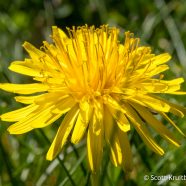Still Not Spring
It is not spring even though many Clouded and Orange Sulphur butterflies continue flying and feeding on nectar sources like this dandelion. Something that gives away the relative date of this photo is the low sun angle adding light from the side as we are less than two months from the winter solstice. You can also see a little bee mimic fly venturing into the flower, too.
Read MoreCabbage White
The Cabbage White (Pieris rapae) is a non-native “pest” butterfly species, and here you can see it is feeding on a Dandelion (Taraxacum officinale), a non-native weed…but you know what, the ship has sailed on trying to solve that problem. I realize that is easy for me to say because I am not employed in agriculture. However, we are not going to wake up tomorrow and eliminate these species from North America. Even if we were to try it would be terribly harmful, and in the case of the dandelion we would be pumping even more toxic chemicals into our environment – as...
Read MoreDandelion Feast
The dandelion is one of the most widespread and widely known flowering plants there is, and while they may not be the best for agriculture or maintaining the “perfect” manicured lawn, they are very helpful for our early pollinators. Undoubtedly you have seen bees, butterflies and other flying insects feeding on them when there is little else blooming. Here’s to them! Besides, they’re pretty little things once you stop thinking about making the grass look “neat” and “tidy”. Scott Kruitbosch Conservation & Outreach...
Read MoreChristmas Dandelion
I photographed this lovely little dandelion blooming yesterday…yes, this is a Christmas dandelion. It was in Connecticut, the state that is a part of New England, on December 25. These temperatures may be enjoyable for some of us, but such a shift is not helping our plant or animal life. They need a prolonged, uninterrupted dormant period, and starting to “go” now only to be put back in more eventual cold and snow for a couple months may harm them later. We are likely to stay above-average for temperatures, but it will nevertheless cool off to something more seasonable. The...
Read MoreBlack Swallowtail
After a long, cold and snowy winter it has taken a bit of time for the first Lepidoptera to start to emerge, but we are off! We will definitely be showing you more of the butterflies and moths we spot over the next several months. Here we have the Black Swallowtail (Papilio polyxenes) enjoying those “weeds”, also known as early season sources of nectar and pollen for our insects. Scott Kruitbosch Conservation & Outreach Coordinator
Read More








